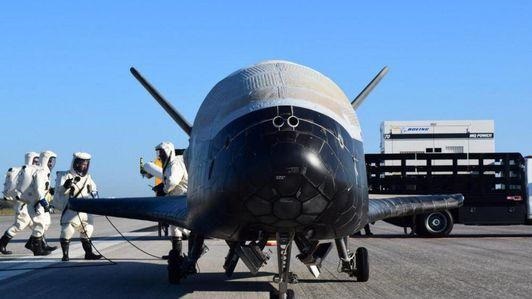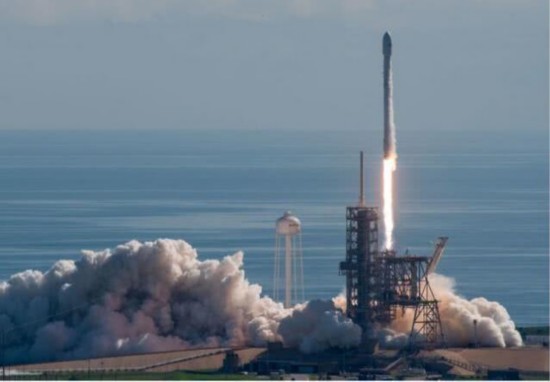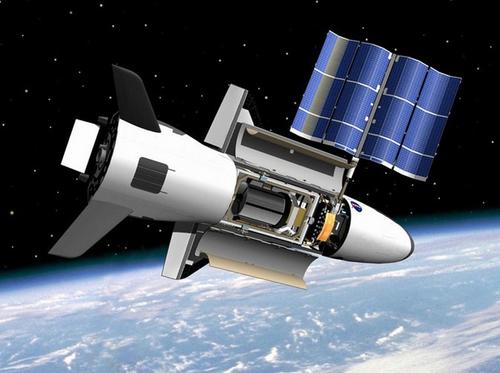| Space: Elusive Enigma Flies Again
太空:难以捉摸的谜团 X-37B UOV将再次飞行 Date:2020-05-07 Source:strategypage By:Globalmil Viewed: |

May 6, 2020: The U.S. Air Force X-37B UOV (unmanned orbital vehicle) is scheduled to go into space for the sixth time in mid-May, seven months after the other X-37B returned from its last, and longest (25.5 months) mission. The X-37B has been doing this for a decade now, going into orbit for the first time in April 2010, for over seven months. Each subsequent launch (March 2011, December 2012, May 2016 and September 2017) kept the X-37B in orbit longer (225 days then 469, 675, 718 and 780). There are actually two X-37B “space planes” so they are not putting the same one back into orbit soon after it returns.
2020年5月6日:美国空军的X-37B无人轨道飞行器(unmanned orbital vehicle)计划于5月中旬第六次进入太空,这是在另一架X-37B完成最后一次也是最长一次(25.5个月)任务返回七个月之后。X-37B已经这样进行10年了,2010年4月首次进入轨道,运行超过7个月的时间。随后的每次发射(2011年3月、2012年12月、2016年5月和2017年9月)都会使X-37B在轨道上停留更长时间(225天,然后是469天、675天、718天和780天)。实际上有两架X-37B“太空飞机”,所以它们不会在返回后不久将同一架X-37B送入轨道。
One unanswered question is; what does X-37B do up there? The X-37B operations are classified secret and little information about what happens in orbit is released. The most recent X-37B mission caused a problem when the air force mentioned that the X-37B had carried and released three cubesats (very small satellites) that were not registered with the UN. That X-37B was known to be carrying ten cubesats to be released into orbit to perform various experiments. Cubesats are technically U Class spacecraft that can be no larger than 10 cm (about four inches) square and weigh no more than 1.33 kg (2.9 pounds). Cubesats are increasingly popular for science experiments by smaller organizations or even individuals, that cannot afford a multi-million dollar satellite that is ten or more times larger and heavier than a cubesat. So far over 1,200 cubesats have been launched since 1998, with about 93 percent reaching orbit. That number is expected to double in the next few years because more and more commercial satellite launchers are providing unused space and weight on their launcher rockets for carrying and launching some cubesats. In some cases, the cubesat owners pay for this service while in other cases some cubesats are taken up for free, as a public service. The U.S. is accused of using the unregistered cubesats launched from the X-37B as a test of a new anti-satellite weapon. A cubesat placed in the proper orbit could intercept and destroy or disable a much larger satellite. Or so the theory goes. The U.S. Air Force has no comment although two senior air force officials did mention, in 2019, that there were some secret anti-satellite projects underway. An anti-satellite weapon that is kept secret is more effective when used because the enemy doesn’t know what to prepare for.
一个未解决的问题是:X-37B在那做什么?X-37B的运行是保密的,很少发布有关在轨情况的信息。最近的一次X-37B任务引起了一个问题,当时空军提到X-37B携带并释放了三颗未在联合国注册的立方体卫星(非常小的卫星)。据悉,X-37B载有10颗立方体卫星,将被释放到轨道上进行各种实验。立方体卫星在技术上是U级航天器,其面积不超过10厘米(约4英寸),重量不超过1.33千克(2.9磅)。立方体卫星在小型组织甚至个人的科学实验中越来越受欢迎,因为他们买不起比立方体卫星大10倍或更重、价值数百万美元的卫星。到目前为止,自1998年以来,已经发射了1200多颗立方体卫星,其中93%到达轨道。由于越来越多的商业卫星发射器为运载和发射一些立方体卫星提供了未使用的空间和重量,预计这一数字在未来几年内将翻一番。在某些情况下,立方体卫星的所有者为这项服务付费,而在其他情况下,一些立方体卫星作为一项公共服务被免费使用。美国被指控使用从X-37B发射的未经注册的立方体卫星作为一种新的反卫星武器的试验。放置在正确轨道上的立方体卫星可以拦截、摧毁或使一颗更大的卫星失灵。理论上是这样的。尽管美国空军两名高级官员在2019年确实提到,有一些秘密反卫星项目正在进行,但美国空军对此不予置评。一种保密的反卫星武器在使用时更有效,因为敌人不知道要防备什么。
America, Russia and China are the major players in orbital space and ASAT (anti-satellite weapons) development. This is mainly because these three countries own or operate most of the commercial and military satellites up there. Some other countries are active with ASAT as well. In March 2020 India tested an ASAT weapon when they launched one of their anti-missile missiles with the third stage “interceptor” reconfigured to hit an object in orbit rather than an ICBM warhead plunging towards earth. The target was a small Indian satellite launched in 2019 into a low (280 kilometers) orbit. This meant that when the ASAT warhead hit the satellite the resulting debris (hundreds of fragments) would soon fall to earth and burn up in the atmosphere. The target satellite was apparently launched just to be an ASAT target.
美国,俄罗斯和中国是轨道空间和ASAT(反卫星武器)发展的主要参与者。这主要是因为这三个国家拥有或操作空间中的大多数商业和军事卫星。其他一些国家也积极参与ASAT。2020年3月,印度测试了一种ASAT武器,当时他们发射了一枚反导弹导弹,第三级“拦截器”被重新配置为击中在轨物体,而不是将一枚ICBM(洲际弹道导弹)弹头重入地球。目标是一颗2019年发射到低(280公里)轨道的小型印度卫星。这意味着,当ASAT战斗部击中卫星时,所产生的碎片(数百个碎片)将很快掉落到地球并在大气层中燃烧殆尽。目标卫星发射显然只是为了成为反卫星武器的目标。
China conducted a similar test in 2007 but destroyed one of their own satellites that was no longer functional and in a higher orbit. The Chinese ASAT test debris are still in orbit and China is still criticized for this test. Other nations, including the big three, are working on ground bases electronic weapons for disabling satellite. Russia has some ambitious ASAT plans but no money to build their airborne ASAT laser (to blind or destroy low orbit spy or communications satellites), or the orbital satellite jammer powered by a nuclear reactor. Russia can afford more ground-based jammers and such and they putting as much money as they can into that. So is China, which has a lot more cash. But so are nations like Japan and even less affluent states like North Korea and Iran.
中国在2007年进行了类似的试验,但摧毁了自己的一颗失效卫星,处于更高的轨道。中国的ASAT试验碎片仍在轨道上,中国仍因这次试验而受到批评。包括三大国在内的其他国家,也在研发使卫星失效的地面电子武器。俄罗斯有一些雄心勃勃的ASAT计划,但没有资金来建造自己的机载ASAT激光(用于致盲或摧毁低轨道间谍或通信卫星),或由核反应堆提供动力的在轨卫星干扰器。 俄罗斯可以负担得起更多的地基干扰器,它们可以投入尽可能多的资金。拥有大量资金的中国也是如此。但是像日本这样的国家,甚至像朝鲜和伊朗这样的不太富裕的国家,也是如此。
And then there’s the mysterious X-37B. It is unmanned and operated by earth-based controllers. It does have automatic landing software that has been used several times without any problems. While the air force reports few details about the X-37B it was difficult to hide the fact that mission 5 used a different launch vehicle; the SpaceX booster. This was important because the SpaceX rocket itself is reusable and the first stage returns to earth and lands upright for refurbishing and reuse. Air force officials noted that the SpaceX design is a fitting match for X-37B which was designed for multiple reuse and autonomous operation. Mission 5 was apparently similar to Mission 4 in that new technologies were tested and more micro-satellites were placed in orbit, including the unregistered cubeSats, which are the smallest class of satellites.
然后是神秘的X-37B,它是无人驾驶的,由地面控制者操作。它确实具有已经多次使用而没有任何问题的自动着陆软件。尽管美国空军几乎没有报告有关X-37B的细节,但很难掩盖第五次任务使用另一种运载火箭这一事实。SpaceX助推火箭。这很重要,因为SpaceX火箭本身是可重复使用的,并且第一级以垂直方式着陆进行翻新和再利用。美国空军官员指出,SpaceX设计是与X-37B的完美搭配,该X-37B设计用于多次重复使用和自主运行。第五次任务与第四次任务的相似之处在于,它对新技术进行了测试,并在轨道上放置了更多的微型卫星,其中包括未注册的立方体卫星,这是最小的一类卫星。

2017年9月,搭载美国空军无人驾驶X-37B太空飞机的SpaceX猎鹰9号火箭从美国宇航局肯尼迪航天中心起飞
Mission 6 was originally scheduled for late 2019, using the disposable Atlas 5 launch vehicle normally employed but probably on its way out. SpaceX is cheaper and has a growing list of successful landings including twelve successes in a row, including all ten in 2017. The SpaceX landing tests began in 2010.
第六次任务原定于2019年下半年执行,使用的是通常使用但可能即将退出的一次性阿特拉斯-5型(Atlas 5)运载火箭发射。SpaceX价格便宜,并且成功着陆的次数越来越多,包括连续十二次成功着陆,包括2017年的全部十次。SpaceX着陆测试始于2010年。
It was eventually revealed that mission 4 tested a new thruster system for mobile satellites that needed to be tried out while in orbit. Also carried were dozens of different materials, possibly including some new spy satellite components to see what the harsh environment in orbit, especially the radiation can do. Such exposure can have unpredictable effects on materials and microelectronics after prolonged time in space.
最终发现,第四次测试了一种用于移动卫星的新型推进器系统,该系统需要在轨道上进行试验。同时还携带了数十种不同的材料,可能还包括一些新的间谍卫星部件,以查看轨道上的恶劣环境,尤其是辐射可以做什么。 在太空中长时间停留后,这种暴露会对材料和微电子产生不可预测的影响。
Earlier missions were also successful. The third X-37B mission ended in October 2014 after nearly two years in orbit. The second mission landed on June 16th, 2012 after 15 months in orbit. The first mission ended on December 3rd, 2010 after seven months in orbit. The official endurance of the X-37B was originally about nine months (280 days). The real endurance appears to be 3-4 times that, at least. The long endurance is largely because the X-37B carries a sizable solar panel, which is deployed from the cargo bay, unfolded and produces enough power to keep the X-37B up there for a long time. The air force has not made public much about what the X-37B has been doing up there for nearly 2,000 days so far.
早期的任务也很成功。第三次X-37B任务在轨道运行近两年后于2014年10月结束。第二次飞行任务在轨道运行15个月后于2012年6月16日着陆。经过七个月的飞行,第一次飞行任务于2010年12月3日结束。X-37B的官方寿命最初约为9个月(280天)。真正的寿命至少是它的3-4倍。 持久的使用寿命主要是因为X-37B带有一个相当大的太阳能电池板,电池板布置在货舱中,展开并产生足够的功率,可以长时间将X-37B保持在那里。到目前为止,美国空军尚未公开X-37B在那里进行了将近2000天的活动。

In effect, the X-37B is a remotely controlled mini-Space Shuttle. The space vehicle, according to amateur astronomers (who like to watch spy satellites as well), appears to be going through some tests much of the time. The X-37B is believed to have a payload of about 227-300 kg (500-660 pounds). The payload bay is 2.1x1.4 meters (7x4 feet). As it returned to earth, it is designed to land by itself after being ordered to use a specific landing area. The X-37B weighs five tons, is nine meters (29 feet) long and has a wingspan of 4 meters (14 feet). In contrast, the Space Shuttle was 56 meters long, weighed 2,000 tons and had a payload of 24 tons.
实际上,X-37B是一种远程控制的小型航天飞机。据业余天文学家(他们也喜欢观察间谍卫星)说,航天器似乎在很多时候都在进行一些测试。据信X-37B的有效载荷约为227-300千克(500-660磅)。有效载荷舱为2.1x1.4米(7x4英尺)。当它返回地球时,它被设计在受控命令下使用特定着陆区域后自行着陆。X-37B重5吨,长9米(29英尺),翼展4米(14英尺)。 相比之下,航天飞机长56米,重2,000吨,有效载荷为24吨。
The X-37B is a classified project, so not many additional details were expected to be made available. It's been in development since 2000 but work was slowed down for a while because of lack of money. Whatever the X-37B is now doing up there has been convincing enough to get Congress to spend over a billion dollars on it. What makes the X-37B so useful is that it is very maneuverable, contains some internal sensors (as well as communications gear), and can carry mini-satellites, or additional sensors, in the payload bay. The X-37B is believed capable of serving as a platform for attacks on enemy satellites in wartime. Using a remotely controlled arm, the X-37B could refuel or repair other satellites. All this is estimates because, as a classified project, there is little confirmed information about its payload or mission, other than testing the system on its first mission. It is likely that future missions will involve intelligence work, and perhaps servicing existing spy satellites, which use up their fuel to change their orbits. For regular satellite refueling missions a larger “X-37C” would probably be used. This is a scaled-up X-37B that would have a much larger (probably over a ton) of payload. The X-37C could be quickly switched between cargo and passenger configurations. The X-37C would still be robotic and not require anyone onboard to control it. Work on the X-37C has apparently been halted because there are similar alternative designs that are closer to service.
X-37B是机密项目,因此预计不会提供很多其他细节。自2000年以来一直在开发中,但是由于缺乏资金而使工作放慢了一段时间。不管X-37B现在在做什么,已经足够令人信服地让美国国会在它上面花费超过10亿美元。X-37B之所以如此有用,是因为它具有很高的机动性,包含一些内部传感器(以及通信设备),并且可以在有效载荷舱中携带小型卫星或其他传感器。据信X-37B可以作为战时攻击敌方卫星的平台。使用遥控臂,X-37B可以为其他卫星加燃料或维修。所有这些都是估计的,因为作为机密项目,除了在第一次任务中测试系统之外,几乎没有关于其有效载荷或任务的确认信息。未来的任务很可能会涉及情报工作,也许还会为现有的间谍卫星提供服务,这些卫星会耗尽燃料来变轨。对于常规的卫星加燃料任务,可能会使用较大的“ X-37C”。这是X-37B的按比例放大尺寸,其有效载荷会更大(可能超过一吨)。X-37C可以在货物和乘客配置之间快速切换。X-37C仍将是机器人,不需要机上任何人进行控制。 X-37C的工作显然已停止,因为有类似的替代设计更接近服务。

The X-37B also demonstrated that it could not be easily tracked while in orbit although at times the X-37B could be elusive for amateur astronomers. The international collection of amateur skywatchers have proved remarkably adept at spotting orbital objects in the past, including classified ones like the X-37B. The amateur orbital observer community has concluded that one thing the X-37B tested was how well it could constantly switch positions, and stay hidden. In that respect, the X-37B was a resounding success. That's because these amateur observers are generally very good at tracking what's up there.
X-37B也证明了它在轨道上不容易被跟踪,尽管有时对业余天文学家来说X-37B可能是难以捉摸的。在过去,国际上业余天文爱好者的收藏证明了他们非常善于发现轨道物体,包括像X-37B这样的机密物体。业余轨道观测者团体得出的结论是,X-37B测试的一件事是它能在多大程度上不断地变换位置,并保持隐蔽。在这方面,X-37B取得了巨大的成功。这是因为这些业余观测者通常非常擅长追踪上面的东西。
One notable incident occurred in 2008 when a U.S. spy satellite fell out of orbit, apparently because of a failure in its maneuvering system. The amateur astronomers were able to track it. If this had not been an American reconnaissance satellite, there would have been no media attention to this, because 4-5 satellites a month fall back to earth. Since most of the planet is ocean, or otherwise uninhabited (humans like to cluster together), the satellites tend to come down as a few fragments, and rarely is anyone, or anything manmade, hit.
一个值得注意的事件发生在2008年,当时一颗美国间谍卫星脱离轨道,显然是因为其机动系统出现故障。业余天文学家能够追踪到它。如果不是美国的侦察卫星,就不会有媒体注意到这一点,因为每月有4-5颗卫星坠落地球。由于地球的大部分是海洋,或者其他无人居住的地方(人类喜欢聚集在一起),卫星往往会以一些碎片的形式坠落,很少有人或任何人造的东西被击中。
Before the Internet became widely used after 2000 you heard very little about all these injured or worn-out space satellites raining down on the planet. But with the Internet, the many thousands of amateur astronomers could connect and compare notes. It was like assembling a huge jigsaw puzzle. Many sightings now formed a pattern, and a worldwide network of observers made visible the movements of hundreds of space satellites. These objects were always visible at night, sometimes to the naked eye, but unless you knew something about orbits and such, they could be difficult to keep track of. These days, a lot of the activity is posted and discussed at http://www.satobs.org/. But the X-37B has proved elusive and sometimes became a frustrating challenge to the amateur sky watchers. This is pleasing to American air force officials, who designed the X-37B to be elusive to terrestrial observation and the dedicated (and quite effective) amateur satellite watchers gave the X-37B quite a workout.
在2000年互联网被广泛使用之前,你很少听到这些损坏或破损的太空卫星坠落在地球上的消息。但有了互联网,成千上万的业余天文学家可以连接和比较笔记。就像组装一个巨大的拼图游戏。现在,许多目击事件形成了一种模式,一个世界性的观察网络使得数百颗太空卫星的运动清晰可见。这些物体在晚上总是可见的,有时肉眼也能看到,但是除非你对轨道等有所了解,否则可能很难跟踪它们。如今,很多活动都在http://www.satobs.org/上发布和讨论。但X-37B已经被证明是难以捉摸的,有时成为一个令人沮丧的挑战,业余天文爱好者。这让美国空军官员感到满意,他们设计的X-37B对地面观测来说是难以捉摸的,而专门(而且相当有效)的业余卫星观测者给了X-37B相当大的锻炼。
上一篇:Winning: Turkey Takes On China 下一篇:Electronic Weapons: Straight Out Of China And Microsoft
| The Booker dilemma: inside US Army transformation
“布克”困境:美国陆军转型内幕 |
| The decision to cancel the M10 Booker light tank is at the core of a reordering of US Army planning.... [2025-07-16] |
| Focus: A fragile balance in Asia, China has become leading military power in the
焦点:亚洲平衡脆弱,中国已成为该地区的主要军事力量 |
| However, China's rapid military growth in this area is tipping the balance in favor of regional power. ... [2024-08-27] |
| Small drones will soon lose combat advantage, French Army chief says
法国陆军总司令表示,小型无人机将很快失去战斗优势 |
| By Rudy Ruitenberg Thursday, Jun 20, 2024 作者:鲁迪瑞滕伯格 2024年6月20日星期四 French Army Chief of Staff Gen. Pierre Schill inspecting a Rapid Eagle anti-drone system at the Eurosatory defense show in Paris on June 19, 202... [2024-08-18] |
| What’s next for Ukraine’s incursion into Russia?
乌克兰入侵俄罗斯的下一步是什么? |
| Ukraine’s forces have surprised us all with its recent incursion into Russia’s Kursk Oblast since the operation to turn the tide of the war,... [2024-08-17] |
